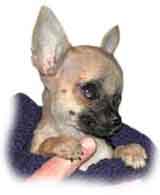Small Dog BreedsInformation About The Welsh Terrier Dog Breed |
|
|
The Welsh Terrier has a sturdy, athletic medium-sized body with a docked tail and a short, wiry, and low-maintenance coat. His appearance is similar to the Airedale and also shares common characteristics with the Irish and Lakeland Terriers. He is bold, spirited, affectionate, obedient, and gets along well with children. With his handy size, fun attitude, and good temperament, he makes a wonderful household pet. As a puppy, this breed is sensitive to overbearing or rushed training methods. He is reserved around strangers, tends to be dog-aggressive, and has a high prey drive. As a youngster, he can be timid and requires lots of confidence-building and positive reinforcement. Because he can be stubborn, he needs precise and persistent guidance. He is a little slow in processing information and may get confused if pushed too fast. Size: This breed stands at 14-15.5in at the shoulder and weighs approximately between 18-22lb. History and origin: The Welsh Terrier is a very old breed that was developed in Wales to hunt fox, otter, and badger. His direct ancestor is the Black and Tan Terrier which is also the progenitor of many terrier breeds. He is of the Celtic origin and a close relative to the Irish Terrier. In fact, 2 strains of this breed once existed side by side, one that evolved by the Welsh from a purpose-bred coarse-haired Black and Tan Terrier and an English type that was developed by crossing the Airedale and the Fox Terrier. The English type appears to have vanished and the true Celtic strain remained and was presented in 1885. The Welsh Terrier Club was founded a year later. The following year, the breed was awarded the championship status by the British Kennel Club. The first Welsh Terriers were taken to the United States in 1888. Feeding: Recommended feeding for this breed is 1-1 ½ cans (13.3oz size) of high-quality meat product with added biscuit of the same amount or 3 cupfuls of complete dry food. Exercise: This breed was originally bred to run with a pack of hounds and would enjoy a nice run in a wide-open space. However, he can easily adapt to apartment living as long as he is given plenty of walks and runs. Grooming: His coat has minimal shedding and requires regular brushing to keep it in good condition as well as regular trimming every 3 months. During winter, the coat is usually left a little longer to provide additional warmth. Show dogs require hand-stripping, which is a plucking procedure that preserves the texture and luster of the coat.Back to the Small Dog Breed page
| |
|
Related News About Dogs ' ); // get rid of newsfeed display by carp CarpConf('poweredby',''); CarpCacheShow('http://www.small-dog-info.com/support-files/rss.xml'); ?>
|
|
|
|
|
|
Copyright © 2006-2007 dogguidance.com |


